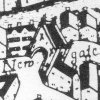Pepys at Bristol
When diarist Samuel Pepys came to Bristol in 1668, he was mightily impressed by the city. For his darling Deb it was a home-coming.

Portrait of Samuel Pepys in 1666 by John Hayls. (National Portrait Gallery).
Samuel Pepys (pronounced 'peeps') was in the prime of life when he visited Bristol. He was 35 years old and a respected naval administrator. He had a weakness though. Although married to a wife he adored, Pepys could never resist a pretty woman.
A Londoner to the core, Pepys had been well educated at St Paul's School there and Magdalene College, Cambridge. Then he was taken into the household of his cousin Edward Montagu, a landowner and politician. Montagu commanded the fleet that brought Charles II back from exile. His reward was to be created Earl of Sandwich and First Lord of the Admiralty. Pepys rose with his patron, being appointed a clerk to the Navy Board. He threw himself into his work. His love of order and efficiency made him an excellent civil servant.
Pepys began his diary on the first of January 1660. Perhaps it was a New Year resolution to keep this frank record of his doings. He never intended it to be read by others, which is half its charm. We see here the whole Pepys, with all his strengths and failings.
As an ardent young man, Pepys had married the fifteen-year-old Elizabeth St Michel, daughter of a penniless Huguenot exile. Clearly it was a love match. Pepys was proud of her beauty and suffered agonies of jealousy. Yet he strayed again and again from the path of marital fidelity. When he visited Bristol he was in the grip of an intense infatuation with his wife's maid, pretty Deborah Willet.
In June 1668 Samuel set out on a tour with Elizabeth, Deborah,
a young cousin of his called Betty Turner, and his faithful Navy clerk Will Hewer.
They saw the sights at Oxford and Salisbury. Then Pepys was tempted to
go on to Bath and Bristol. That pleased both Somerset-born Elizabeth
and the Bristolian Deborah. At Bath the party was roused at dawn to try
the waters of the Cross Bath. Pepys sniffed Methinks it
cannot be clean to go so many bodies together in the same water.
Later that same morning the tireless travellers left in a hired coach for Bristol. Around two o'clock they arrived at the Horse Shoe, an inn on Wine Street. From there they walked through the city, "which is in every respect another London." A Londoner could pay no greater compliment! Pepys noticed the absence of carts. Bristol Council had barred them from the city, to prevent heavy loads from crushing the vaults beneath the streets. Goods had to be dragged on sledges.
Rather than return to the inn to eat, Pepys sought out a
tavern. He was directed to the Three Cranes. This was in Fish Lane, now
called St Stephen's Street. Finding its landlord on the point of
shutting up the tavern, having made enough money to retire, they moved
on to the Sun in Christmas Street. There Pepys left Elizabeth with the
mistress of the house and strolled off to explore the quay, which
is a most large and noble place.
At this time the quay
stretched right up to a bridge linking Christmas Street and Christmas
Steps. Where now the Frome runs underground, Pepys saw ships on the
open river. He was particularly keen to view a new warship being built
for the Royal Navy.
 He returned to the Sun to find that
Deborah had rooted out her uncle, William Butts. Pepys thought him
He returned to the Sun to find that
Deborah had rooted out her uncle, William Butts. Pepys thought him a
sober merchant, very good company.
After a meal spiced with
good conversation, the visitors were escorted around the quay by an
informative Mr Butts. He showed them the newly-built Custom House on
Welsh Back, with its glittering display of windows.
When he led the party through Marsh Street, where Deborah had
been born,
there were affecting scenes. The joy that was among the old
poor people of the place, to see Mrs. Willet's daughter!
Then
Butts sprang a surprise. He took them by a back way to his house, and
fortified them with strawberries, a whole venison pasty,
cold, and plenty of brave wine, and above all Bristol milk.
This was the popular blend of sherry that was to inspire the name of
Harvey's Bristol Cream. Pepys was as much impressed by the merchant's
solid, well-furnished house as his lavish hospitality.
It was very late when Butts at last escorted the visitors back to the Horse Shoe, impressing them with the High Cross on the way. Pepys and his party returned to Bath by moonlight.
























